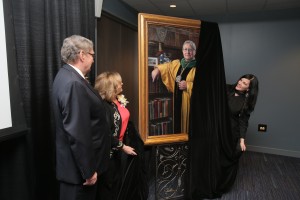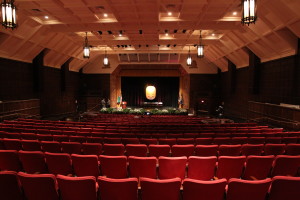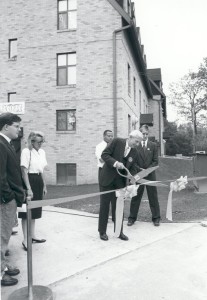Presidential History Across Campus
By Patty Gelb
The University of Toledo Alumni Association is delighted to welcome Dr. Sharon L. Gaber as the 17th president of The University of Toledo.
The president is the leader who guides the University’s course and the Office of the President has a long and extensive history that is represented across the campuses of UT. Students and alumni may not realize when they walk across campus that many buildings they visit, study and live in are named in honor of presidents of past.
 The most recent naming happened this month honoring UT’s 16th president, Dr. Lloyd Jacobs.
The most recent naming happened this month honoring UT’s 16th president, Dr. Lloyd Jacobs.
On March 19, UT renamed its simulation center on the Health Science Campus the Lloyd A. Jacobs Interprofessional Immersive Simulation Center. Jacobs’ presidential portrait, painted by Leslie Adams (Bachelor of Fine Arts, ‘89), who also painted the portrait of the 15th president, Dr. Daniel Johnson, was unveiled at the event. Serving as UT’s president from 2006 to 2014, Jacobs oversaw the merger between the Medical College of Ohio and UT. He served as the sixth president of MCO before the merger.
UT has traditionally honored past presidents by naming structures after them. It only takes a quick glance through the list of presidents to recognize many names as facilities on campus.
 Alumni who have attended a music or theater event at University Hall probably sat in the Doermann Theatre which was built in 1931 and named after UT’s sixth president, Henry J. Doermann (1928-1932).
Alumni who have attended a music or theater event at University Hall probably sat in the Doermann Theatre which was built in 1931 and named after UT’s sixth president, Henry J. Doermann (1928-1932).
The entire appearance of the University was inspired by Doermann. He is recognized as the father of the general structural design of the University. He proposed a collegiate gothic architectural design following universities of Europe at the time. He felt that this look would be inspiring for students and he fought objections of those who felt the project was a waste of money. It was under his presidency that University Hall, the very first building constructed on the Bancroft Campus, was completed in 1931. Doermann dreamt of a central tower that could be spotted from anywhere on campus and today the 206-foot bell tower is a Toledo icon for residents, students and alumni.
Students who lived in MacKinnon Hall or the Dowd-Nash-White dormitories may not have known that they were living in buildings named after past UT leaders.
 MacKinnon Hall is the oldest remaining residence hall. It was named for Lee MacKinnon, who served as the chief academic officer in the late 1920s and early 30s. Although MacKinnon was offered the presidency twice, he turned down the office but stepped in as acting president three times following the untimely deaths of university presidents. MacKinnon Hall was built and named after the former chief academic officer in the 1930s with funding from the federal government’s New Deal program. MacKinnon Hall was deemed necessary to provide a safe place for female students to live away from home.
MacKinnon Hall is the oldest remaining residence hall. It was named for Lee MacKinnon, who served as the chief academic officer in the late 1920s and early 30s. Although MacKinnon was offered the presidency twice, he turned down the office but stepped in as acting president three times following the untimely deaths of university presidents. MacKinnon Hall was built and named after the former chief academic officer in the 1930s with funding from the federal government’s New Deal program. MacKinnon Hall was deemed necessary to provide a safe place for female students to live away from home.
Future students will not have the opportunity to create memories while living at Dowd-Nash-White like many alumni did. The Dowd-Nash-White dormitories were built in 1953 as a part of the University’s response to the post-World War II enrollment boom and were originally designed as housing for male students. The dormitories were named for three of UT’s past presidents—John Dowd (1925-1926), Philip Nash (1933-1947) and Wilbur White (1948-1950).
These dormitories have since been demolished but the names Dowd, White and Nash live on. The University of Toledo’s Board of Trustees recently approved changing the name of The Crossings, a new dormitory on the southwest side of campus, to Presidents Hall. The four main halls within the building are now named Dowd, Nash, White and Johnson. Johnson Hall was named in honor of President Johnson, who served as UT’s president from 2001-2006.
Former students may have memories of cramming for that exam at the Carlson Library named after William S. Carlson, UT’s 10th president (1958-1972). Carlson held the office longer than any past president at 14 years and was a strong supporter of research. He added research and scholarship to the job requirements of the faculty during his tenure. He also instituted the honors program and was at the helm in 1967, when UT became a state university. He was a dedicated researcher and author of several books which made naming the library after him fitting.
 Home to sororities and fraternities on the campus of UT, McComas Village is located very close to the Glass Bowl and Parks Tower. The village was opened in the fall of 1990 and in February of 1994, it was named McComas Village after James D. McComas, UT’s 12th president (1985-1988). Dr. McComas had a brief tenure at UT, but during his time at the University he established the Presidential Scholars program and continued the expansion of facilities across the campus to include the Greek village that was named after him.
Home to sororities and fraternities on the campus of UT, McComas Village is located very close to the Glass Bowl and Parks Tower. The village was opened in the fall of 1990 and in February of 1994, it was named McComas Village after James D. McComas, UT’s 12th president (1985-1988). Dr. McComas had a brief tenure at UT, but during his time at the University he established the Presidential Scholars program and continued the expansion of facilities across the campus to include the Greek village that was named after him.
The Horton International House was named after Dr. Frank Horton, the 13th president of UT (1989-1998). Under his occupancy of the president’s office, UT experienced expansion with the construction of 14 different buildings. Some of those buildings include the International House, a student health center, the Center for Visual Arts at the Toledo Museum of Art, an expansion of the Student Union and Wolfe Hall. It was also during Horton’s presidency that the University launched and successfully completed a $40 million fundraising capital campaign called UT40.
Even the home of the UT Alumni Association is in honor of a past president. The Driscoll Alumni Center is named after Glen R. Driscoll, UTs 11th president (1972-1985). During his time as president he continued the expansion of the University’s physical footprint, building the Student Union, Law Center, Centennial Hall, Center for Performing Arts and Stranahan Hall. When he retired from the presidency in 1985, the continuing education building was named after him. At the time the Alumni Association only had a couple of employees and took up a small space in the building. Now, with over 70 employees between the UT Foundation, Alumni Association and development staffs, the Driscoll Alumni Center is almost entirely dedicated to office space.
There is a rich history of the past leaders of our University all across campus and now UT welcomes Dr. Gaber. The Alumni Association looks forward to many future opportunities for alumni and friends to meet our newest president with the likelihood that one day students will study or live in a building on the campus named after UT’s 17th president.






